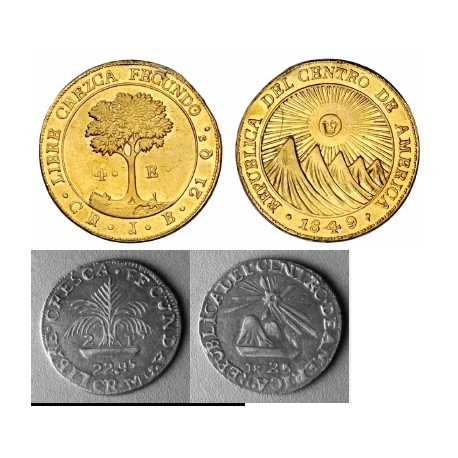Cart
0
Product
Products
(empty)
No products
To be determined
Shipping
$0.00
Total
Product successfully added to your shopping cart
Quantity
Total
There are 0 items in your cart.
There is 1 item in your cart.
Total products
Total shipping
To be determined
Total
More info
Prooflike
½
Onzas 1850 from Costa Rica: true Specimens or something else?
Carlos Jara. Introduction
The coinage series of Costa Rica appears rather short when compared to other countries, such as Guatemala, Chile or Argentina. However, a few outstanding rarities, mostly in the gold series, are present. The most important ones, from a historical and numismatic persperctive, are undoubtedly the provisional gold issues struck in 1825, of which only a few specimens are known, one of which is illustrated below:
Figure 1: Provisional Costa Rica Gold 2 Pesos 1825, the only specimen known, private collection (enlarged)
Other famous rarities among the gold series are the 1837 “F” 8 Escudos, the 1828 1 Escudo, and the 1849 4 Escudos (all struck with the design of the Central American Republic). The latter was the last gold coin struck in Costa Rica with Central American Republic dies. Only 415 specimens were struck, as we will see further on, of which only a very few (I’d venture to say between 5 and 10) survive.
Figure 2: Costa Rica 4 Escudos 1849 JB (Juan Barth). The Eliasberg specimen.
1
1
See http://www.coinfactswiki.com/wiki/Costa_Rica_1849-CR_JB_4_escudos.



On the other hand, the coin subject of this article, which is part of first issue of gold coins struck with the “
Republica de Costa Rica
” dies, is not nearly as rare as the previously mentioned coins: we are referring to the 1850
½
Onza (equivalent to 4 Escudos), referenced in Krause-Mishler
2
as KM-100, and in Friedberg’s “
Gold Coins of the World
” as Fr-7
3
. In fact, the 1850
½
Onza is among the more available Costa Rican gold coins, if one does not search for high grade specimens (meaning strictly Uncirculated ones), since coins in VF or lower grades can be labeled as downright common. The normally encountered examples are neither visually appealing since another characteristic of this issue is that almost all known examples show an imperfect strike, and lack details in the area near the sun in the shield, and in the face of the standing liberty. A case in point is the following coin, which although graded as AU in a recent auction sale, which contained an important Costa Rican collection
4
, lacks the mentioned details:
2
Krause, Chester L., and Colin R. Bruce II,
Standard Catalog of World Coins: Spain, Portugal and the New World
, 2002.
3
Friedberg, Arthur L. and Ira S. Friedberg,
Gold Coins of the World, From Ancient Times to the Present, 7
th
ed.
, 2003.
4
Spink-Smythe:
The Frederick R. Mayer Collection Of Costa Rica
, (October 23, 2008), lot # 1190.

Figure 3: description and illustration of lot # 1190 in the auction of the Mayer collection (enlarged).
However, there exist a very few known coins of this issue which show a much better strike, and glowing surfaces, evidence of a much better die state. I have so far censed three different such coins, which are identified below. The difference in quality of strike and surfaces between these three coins and their normally encountered counterparts is so prominent, that two of said three coins have been graded as either Proof, Prooflike or Specimen issues when described in recent auction appearances. Let us now detail the appearances/pedigrees of the aforementioned three different specimens: -
the coin presently housed in the Smithsonian Institution collection, and therefore very probably from the Josiah Lilly holdings. In the opinion of Manuel Chacón (curator of the Numismatic Museum of the Central Bank of Costa Rica), this is the finest known of all 1850
½
Onzas. When seeing it in person, it is indeed hard to disagree:
Figure 4:
½
Onza 1850 from the Smithsonian collection. Perhaps the finest known specimen.
-
the coin in the Hammel collection sold by Stack’s in 1983 (lot # 800 in that sale
5
), and plated and described in that sale as follows:
5
Stack’s:
The Mortimer Hammel Collection of 19th & 20th Century Foreign Gold Coins
, September 15,16, 1982.


Figure 5:
½
Onza 1850 from the Hammel collection (enlarged, scanned from the Stack’s catalog) and its description.
-
The coin plated in Murillo’s “
Historia Numismatica de Costa Rica
”
6
, later sold as part of the Meyer collection by Spink-Smythe
7
, and recently auctioned by Ponterio in NYINC 2011
8
, with the following respective descriptions:
Figure 6: The
½
Onza 1850 from the Mayer collection, graded Specimen-61, lot # 357 in Ponterio’s 2011 NYINC auction.
6
Murillo, Jorge:
Historia de las monedas de Costa Rica: catálogo numismático
, San José, 2004.
7
Spink-Smythe:
The Frederick R. Mayer. Collection Of Costa Rica
, (October 23, 2008), lot # 1191.
8
Ponterio & Associates, Inc. The
2011 N.Y.I.N.C. Auction
, lot # 357.



Figure 7: description and illustration of lot # 1191 in the auction of the Frederick R. Mayer collection of Costa Rica. Figure 8: Description of the
½
Onza 1850 (same coin as above) sold as lot # 357 in Ponterio’s NYINC 2011 auction.


Figure 13: receipt from the Royal Mint’s engraver Benjamin Wyon, settled on November 29, 1850, which included the new dies for the silver and gold coins of Costa Rica, struck beginning in 1850, and also a collar for each one of the proyected denominations
17
.
17
Murillo, op. cit., page 77.




